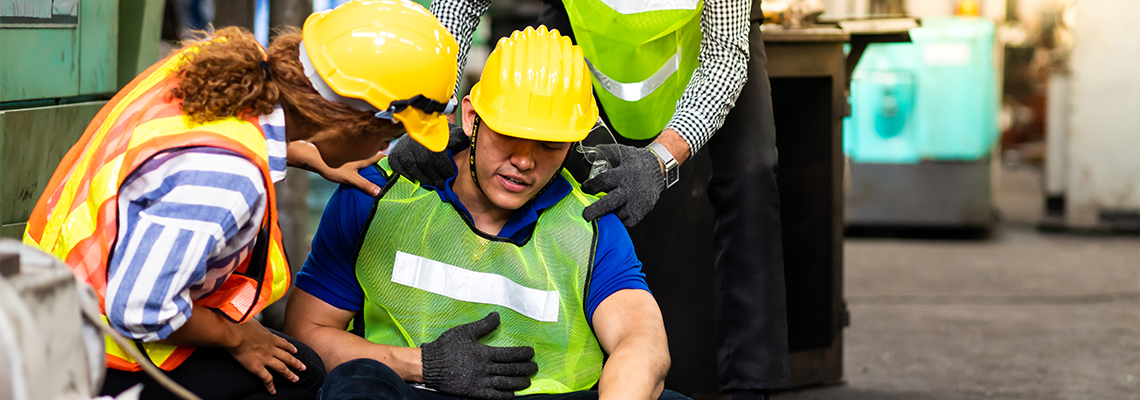
What to Do if You’re Injured While Working on a Construction Site
Knowing what to do if you’re injured while working on a construction site can protect your health, your rights, and your family’s financial future. Whether you’re dealing with a fall from scaffolding, a struck-by incident, or an equipment malfunction, taking the proper steps and understanding how to pursue a claim can help you move forward with confidence.
At The Eskesen Law Firm in New York, I am committed to helping construction workers who have been injured on the job recover the benefits and compensation they need. If you have been injured in a construction site accident, reach out to me today for skilled representation.
An Overview of Construction Site Injuries
Construction sites pose unique hazards that can lead to serious harm, and workers often face risks from heights, heavy machinery, falling objects, and electrical exposure. Injuries on a construction site could involve anything from broken bones and lacerations to head trauma or spinal injuries.
Since construction injuries frequently involve multiple liable parties, such as general contractors, subcontractors, and equipment manufacturers, in some cases, you may have more than a workers’ compensation claim. Therefore, it's important to identify all potential sources of responsibility to understand your options.
Steps To Take Immediately After a Construction Site Injury
If you’ve been injured while working on a construction site, your health should come first. Quick action helps protect both your recovery and any future claim. Take immediate steps to document the scene and preserve any critical evidence or information. The primary steps you should take include the following:
Stop work safely: Stop working and move out of harm’s way. Shut down any equipment you can, if it’s safe to do so.
Seek immediate help: Alert your supervisor and call for on-site medical personnel or emergency services.
Get medical attention: Even if your injuries seem minor, some conditions, such as internal bleeding or concussions, may not be apparent right away. Get a thorough examination from a licensed medical professional to ascertain the status of your health.
Document the scene: Photograph any hazards that led to the accident, equipment positions, and visible injuries before anything is altered. If possible, close off the area until emergency and law enforcement arrive.
Taking these steps can help protect your well-being and preserve crucial evidence for filing a claim for compensation. Failing to report the accident or document the scene promptly can weaken your case and limit your access to benefits.
Additional Steps to Take Following a Construction Site Injury
After suffering an injury, your health should be your main priority. However, once you have received appropriate medical care and documented evidence at the accident scene, there are additional steps you should take to build and file a claim for compensation.
Report the Injury and Attend Workers' Comp Medical Care
After a construction site injury, you must report the accident to your employer as soon as possible under New York law. Providing a written notice within 30 days ensures your right to a workers’ compensation claim and avoids disputes about whether the injury occurred on the job.
Additionally, follow up with authorized medical care designated by your employer or the Workers’ Compensation Board is critical. Your treating physician will document your injuries, prescribe necessary care, and provide reports that support your entitlement to medical benefits and wage replacement.
File a Workers’ Compensation Claim
Once you’ve reported your injury, adhere to the deadlines under New York’s workers’ compensation system. By understanding each step of the claims process, you can reduce the risk of denials that can leave you financially vulnerable.
Complete Form C-3: Your employer must file the First Report of Injury with the Board to open your claim.
Receive notice of claim number: The Board will assign you a unique claim number. Keep it handy for all correspondence.
Attend all medical appointments: Missing scheduled exams can jeopardize your eligibility for continued benefits.
Challenge denials or delays: If your claim is denied or your benefits stall, you can request a hearing before a workers’ compensation judge.
A claim that is handled correctly can provide coverage for medical bills, wage replacement for lost time, and possible benefits for permanent impairments. Remain proactive and informed throughout the process to increase your chances of a fair and timely resolution.
Preserve Evidence and Document Your Injury
Collecting and organizing evidence after a construction accident can help prove fault. Detailed records of what occurred and how you were treated give weight to both your workers’ compensation claim and any third-party lawsuit you pursue. Be sure to document the following items properly:
Accident reports and logs: Request a copy of your employer’s incident report and any safety logs that mention your injury.
Witness statements: Obtain contact information and written accounts from co-workers who saw the accident.
Medical records: Keep copies of all treatment notes, diagnostic imaging reports, and prescriptions.
Equipment maintenance records: If machinery failure caused your injury, obtain copies of the maintenance logs and inspection reports, which can help prove negligence.
Well-organized evidence not only supports your workers’ compensation claim but also lays the groundwork for any third-party lawsuit against negligent contractors or equipment manufacturers.
Understanding Third-Party Liability Claims
When you’re injured while working on a construction site, you may have the right to pursue a third-party claim against someone other than your employer. These claims target parties whose negligence contributed to your injury, such as equipment manufacturers, subcontractors, or property owners.
Unlike workers’ compensation, third-party lawsuits can seek damages for pain and suffering, loss of future earnings, and other non-economic harms. Working with a lawyer helps you identify all potentially liable parties, gather evidence, and coordinate claims alongside your workers’ compensation benefits.
Dealing With Employer Retaliation
Although New York law prohibits retaliation against workers who file injury claims, some employers may pressure you to withdraw your claim or penalize you at work. If you face demotion, reduced hours, or threats after reporting your injury, you have the right to file a retaliation complaint with the Workers’ Compensation Board.
Document any adverse actions, including changes in job duties, performance reviews, or written warnings. Collect emails, memos, or witness testimony that show a link between your claim and the employer’s conduct. Acting swiftly helps protect your workplace rights and can result in additional penalties against the employer.
OSHA and Site Safety Regulations
The Occupational Safety and Health Administration sets mandatory safety standards that employers must follow to protect construction workers. Violations, such as missing guardrails, inadequate fall protection, or faulty scaffolding, can support your injury claim by showing the employer failed to provide a safe workplace.
Documenting OSHA breaches, whether through inspection reports, safety meeting minutes, and violation citations, can potentially bolster your workers’ compensation claim and strengthen any third-party lawsuit by highlighting lapses in site safety.
Return-To-Work Rights and Accommodations
After reporting your injury, New York law requires your employer to offer accommodations that match your medical restrictions. These measures are designed to keep you on payroll while safeguarding your health and typically include the following.
Modified duty assignments: Temporary changes to your tasks or work hours based on your medical restrictions.
Reasonable accommodations: Adjustments such as ergonomic tools, schedule flexibility, or workstation modifications under the ADA.
Transitional work programs: Gradual reintegration plans that help you rebuild stamina and confidence through lighter tasks.
Interactive process: Ongoing communication among you, your employer, and your medical provider to adjust accommodations as your condition evolves.
Using appropriate accommodations can reduce the risk of re-injury and support a faster recovery. Demonstrating your willingness to work within these adjustments also strengthens your workers’ compensation claim.
Speaking to a Lawyer After a Construction Site Injury
Being injured while working on a construction site can be overwhelming, especially when dealing with insurers, medical providers, and legal deadlines. However, an experienced lawyer can help explain your options—whether filing a workers' compensation or third-party claim—handle negotiations with insurers, and represent you at legal hearings.
At The Eskesen Law Firm, I am dedicated to helping you secure the compensation you need for your losses. Located in New York, New York, I serve construction workers throughout New York County, Kings County, Queens County, Bronx County, and Richmond County. Contact me today to schedule a free consultation.
